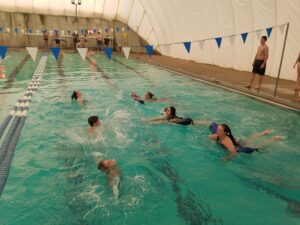RC Lifeguarding

Make sure this is the class for you, no refunds once you sign up.
WHO SHOULD TAKE THIS COURSE?
You must be at least 15 years old and Students must pass a pre course swimming skills test prior to taking lifeguarding courses. Lifeguards are paid to supervise the safety of individuals in and around water. As the water can often be very dangerous, a lifeguard is also responsible for providing emergency assistance to those they are watching. Most are employed by municipalities who manage most of the local aquatic facilities as well as several private companies who operate pools, beaches and waterparks. Not everyone is cracked up to be a lifeguard. Guarding can be both stressful and extremely dangerous. At any given moment a guard may be responsible for watching dozens of people in or around water.
LIFEGUARD TRAINING
Lifeguard Certification course will train and certify participants to be a national lifeguard for swimming pools. The lifeguard certification course includes the following American Red Cross certifications: Lifeguarding, First Aid and CPR/AED for the Professional Rescuer.
We teach a blended learning course format with online education, classroom and in-water components. American Red Cross requires all online content to be completed by prior to the first day of class.
PREREQUISITES FOR LIFEGUARD TRAINING INCLUDE:
-Be at least 15 years old on or before the final scheduled session of the course.
-Swim 300 yards, continuously demonstrating breath control and rhythmic breathing. Candidates may swim using the front crawl, breaststroke or a combination of both, but swimming on the back or side is not allowed. Swim goggles may be used.
-Tread water for 2 minutes, using only the legs. Candidates should place their hands under the armpits.
Complete a timed event within 1 minute, 40 seconds:
-Starting in the water, swim 20 yards. Swim goggles are not allowed.
-Surface dive, feet-first or headfirst, to a depth of 7 to 10 feet to retrieve a 10-pound object.
-Return to the surface and swim 20 yards on the back to return to the starting point with both hands holding the object and keeping the face at or near the surface so they are able to get a breath.
-Exit the water without using a ladder or steps.
If your swimming skills are not strong, but you can swim at least 50 yards and walk the brick test requirement, it may be possible to receive a Shallow Water Lifeguarding card. At any time in the future if you swimming skills increase to the level of deep-water requirements, we will issue the Professional Lifeguarding card that will allow you to guard at both deep water and shallow water pools.

